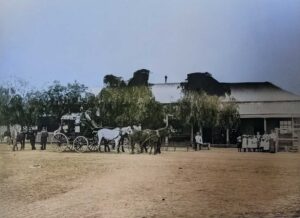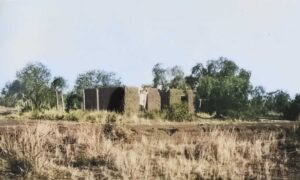One of the key figures in developing the Cobar mines, and therefore Cobar itself, was a man named Charles Campbell, who along with Hartman & Gibbs are credited with identifying the original Copper deposit. Cambell went on to have thriving business in Cobar as the mine developed.
“I stood on the Cobar hill, and looking round saw all the houses with bark or wooden roofs, excepting Campbell’s store, which had an iron roof and was very noticeable.” Recalled a Mrs Mathews. Among his other notable achievements in the district, he is thought to have “built the Tindarie Hotel on the Cobar-Bourke road.”
Tindarey Hotel has license applications from as early as 1873 under ‘Tindara Hotel’ with indications of 2 sitting rooms and 3 bedrooms, or at least ‘beds’ and the Cobar Age of Sat 31st October 1903 mentions the dress worn by Mrs McNabb of the Tindary Hotel – “black dress with satin trimmings” the Globe Hotel in Mt Drysdale
The remote mining locality suffered all the rigours of outback life, including the diseases which decimated many communities, like typhoid. This, from the Newcastle Morning Herald and Miners Advocate, Friday May 26, 1882;
A Population Driven away by Typhoid Fever
The Central Australian (A Bourke paper) records the extraordinary prevalence of typhoid fever at a sawmill, near Three Legs of Man Hotel, Tindary. A man named Lovett, aged 26, was brought in from there last week to the Bourke Hospital, and was attended by Dr Sides, but died in a few hours after arrival. The presence of the disease is attributed to drinking bad water from an old shaft. Seven deaths in all have occurred, and, in consequence, the population of 50 or 60 who were at the place have all left.”



